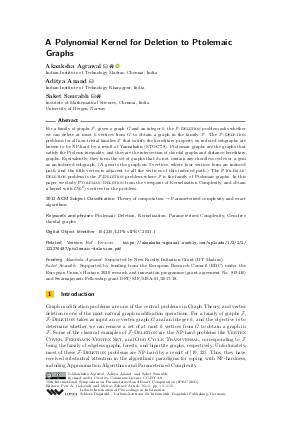A Polynomial Kernel for Deletion to Ptolemaic Graphs
Authors
Akanksha Agrawal  ,
Aditya Anand,
Saket Saurabh
,
Aditya Anand,
Saket Saurabh
-
Part of:
Volume:
16th International Symposium on Parameterized and Exact Computation (IPEC 2021)
Part of: Series: Leibniz International Proceedings in Informatics (LIPIcs)
Part of: Conference: International Symposium on Parameterized and Exact Computation (IPEC) - License:
 Creative Commons Attribution 4.0 International license
Creative Commons Attribution 4.0 International license
- Publication Date: 2021-11-22
File

PDF
LIPIcs.IPEC.2021.1.pdf
- Filesize: 0.81 MB
- 15 pages
Document Identifiers
Related Versions
Subject Classification
ACM Subject Classification
- Theory of computation → Parameterized complexity and exact algorithms
Keywords
- Ptolemaic Deletion
- Kernelization
- Parameterized Complexity
- Gem-free chordal graphs
Metrics
- Access Statistics
-
Total Accesses (updated on a weekly basis)
0PDF Downloads0Metadata Views
Abstract
For a family of graphs F, given a graph G and an integer k, the F-Deletion problem asks whether we can delete at most k vertices from G to obtain a graph in the family F. The F-Deletion problems for all non-trivial families F that satisfy the hereditary property on induced subgraphs are known to be NP-hard by a result of Yannakakis (STOC'78). Ptolemaic graphs are the graphs that satisfy the Ptolemy inequality, and they are the intersection of chordal graphs and distance-hereditary graphs. Equivalently, they form the set of graphs that do not contain any chordless cycles or a gem as an induced subgraph. (A gem is the graph on 5 vertices, where four vertices form an induced path, and the fifth vertex is adjacent to all the vertices of this induced path.) The Ptolemaic Deletion problem is the F-Deletion problem, where F is the family of Ptolemaic graphs. In this paper we study Ptolemaic Deletion from the viewpoint of Kernelization Complexity, and obtain a kernel with 𝒪(k⁶) vertices for the problem.
Cite As Get BibTex
Akanksha Agrawal, Aditya Anand, and Saket Saurabh. A Polynomial Kernel for Deletion to Ptolemaic Graphs. In 16th International Symposium on Parameterized and Exact Computation (IPEC 2021). Leibniz International Proceedings in Informatics (LIPIcs), Volume 214, pp. 1:1-1:15, Schloss Dagstuhl – Leibniz-Zentrum für Informatik (2021)
https://doi.org/10.4230/LIPIcs.IPEC.2021.1
BibTex
@InProceedings{agrawal_et_al:LIPIcs.IPEC.2021.1,
author = {Agrawal, Akanksha and Anand, Aditya and Saurabh, Saket},
title = {{A Polynomial Kernel for Deletion to Ptolemaic Graphs}},
booktitle = {16th International Symposium on Parameterized and Exact Computation (IPEC 2021)},
pages = {1:1--1:15},
series = {Leibniz International Proceedings in Informatics (LIPIcs)},
ISBN = {978-3-95977-216-7},
ISSN = {1868-8969},
year = {2021},
volume = {214},
editor = {Golovach, Petr A. and Zehavi, Meirav},
publisher = {Schloss Dagstuhl -- Leibniz-Zentrum f{\"u}r Informatik},
address = {Dagstuhl, Germany},
URL = {https://drops.dagstuhl.de/entities/document/10.4230/LIPIcs.IPEC.2021.1},
URN = {urn:nbn:de:0030-drops-153840},
doi = {10.4230/LIPIcs.IPEC.2021.1},
annote = {Keywords: Ptolemaic Deletion, Kernelization, Parameterized Complexity, Gem-free chordal graphs}
}
Author Details
Funding
- Agrawal, Akanksha: Supported by New Faculty Initiation Grant (IIT Madras).
- Saurabh, Saket: Supported by funding from the European Research Council (ERC) under the European Union’s Horizon 2020 research and innovation programme (grant agreement No. 819416) and Swarnajayanti Fellowship grant DST/SJF/MSA-01/2017-18.
References
-
Akanksha Agrawal, Sushmita Gupta, Pallavi Jain, and R. Krithika. Quadratic vertex kernel for split vertex deletion. Theoretical Computer Science, 833:164-172, 2020.

-
Akanksha Agrawal, Sudeshna Kolay, Daniel Lokshtanov, and Saket Saurabh. A faster FPT algorithm and a smaller kernel for block graph vertex deletion. In Theoretical Informatics - 12th Latin American Symposium (LATIN), pages 1-13, 2016.

- Akanksha Agrawal, Daniel Lokshtanov, Pranabendu Misra, Saket Saurabh, and Meirav Zehavi. Feedback vertex set inspired kernel for chordal vertex deletion. ACM Trans. Algorithms, 15(1), December 2018. URL: https://doi.org/10.1145/3284356.
-
Akanksha Agrawal, Pranabendu Misra, Saket Saurabh, and Meirav Zehavi. Interval vertex deletion admits a polynomial kernel. In Proceedings of the Thirtieth Annual ACM-SIAM Symposium on Discrete Algorithms, SODA '19, pages 1711-1730, USA, 2019. Society for Industrial and Applied Mathematics.

-
Jungho Ahn. A polynomial kernel for 3-leaf power deletion. Master’s Thesis, KAIST, South Korea, 2020.

-
Jungho Ahn, E. Eiben, O-joung Kwon, and Sang il Oum. A polynomial kernel for 3-leaf power deletion. In MFCS, 2020.

-
Jungho Ahn, Eun Jung Kim, and Euiwoong Lee. Towards constant-factor approximation for chordal/distance-hereditary vertex deletion. In 31st International Symposium on Algorithms and Computation (ISAAC 2020). Schloss Dagstuhl-Leibniz-Zentrum für Informatik, 2020.

-
Yixin Cao and Dániel Marx. Interval deletion is fixed-parameter tractable. ACM Transactions on Algorithms, 11(3):21:1-21:35, 2015.

-
Marek Cygan, Fedor V. Fomin, Łukasz Kowalik, Daniel Lokshtanov, Daniel Marx, Marcin Pilipczuk, Michal Pilipczuk, and Saket Saurabh. Parameterized Algorithms. Springer-Verlag, 2015.

- Marek Cygan and Marcin Pilipczuk. Split vertex deletion meets vertex cover: New fixed-parameter and exact exponential-time algorithms. Information Processing Letters, 113(5):179-182, 2013. URL: https://doi.org/10.1016/j.ipl.2013.01.001.
- Michael Dom, Jiong Guo, Falk Hüffner, and Rolf Niedermeier. Error compensation in leaf power problems. Algorithmica, 44:363-381, April 2006. URL: https://doi.org/10.1007/s00453-005-1180-z.
-
Jack Edmonds. Paths, trees and flowers. Canadian Journal of Mathematics, 17:449-467, 1965.

-
Eduard Eiben, Robert Ganian, and O-joung Kwon. A single-exponential fixed-parameter algorithm for distance-hereditary vertex deletion. Journal of Computer and System Sciences, 97:121-146, 2018.

-
Martin Charles Golumbic. Algorithmic Graph Theory and Perfect Graphs. Elsevier, 2004.

-
Edward Howorka. A characterization of ptolemaic graphs. Journal of Graph Theory, 5(3):323-331, 1981.

-
Bart M. P. Jansen and Marcin Pilipczuk. Approximation and kernelization for chordal vertex deletion. SIAM Journal on Discrete Mathematics, 32(3):2258-2301, 2018.

-
Eun Jung Kim and O-joung Kwon. A polynomial kernel for distance-hereditary vertex deletion. In Algorithms and Data Structures - 15th International Symposium (WADS), volume 10389, pages 509-520, 2017.

-
Jon M. Kleinberg and Éva Tardos. Algorithm Design. Addison-Wesley, 2006.

-
John M. Lewis and Mihalis Yannakakis. The node-deletion problem for hereditary properties is NP-complete. Journal of Computer and System Sciences, 20(2):219-230, 1980.

-
Dániel Marx. Chordal deletion is fixed-parameter tractable. Algorithmica, 57(4):747-768, 2010.

- Ryuhei Uehara and Yushi Uno. Laminar structure of ptolemaic graphs with applications. Discrete Appl. Math., 157(7):1533-1543, April 2009. URL: https://doi.org/10.1016/j.dam.2008.09.006.
-
Mihalis Yannakakis. Node- and edge-deletion np-complete problems. In Proceedings of the 10th Annual ACM Symposium on Theory of Computing (STOC), pages 253-264, 1978.

